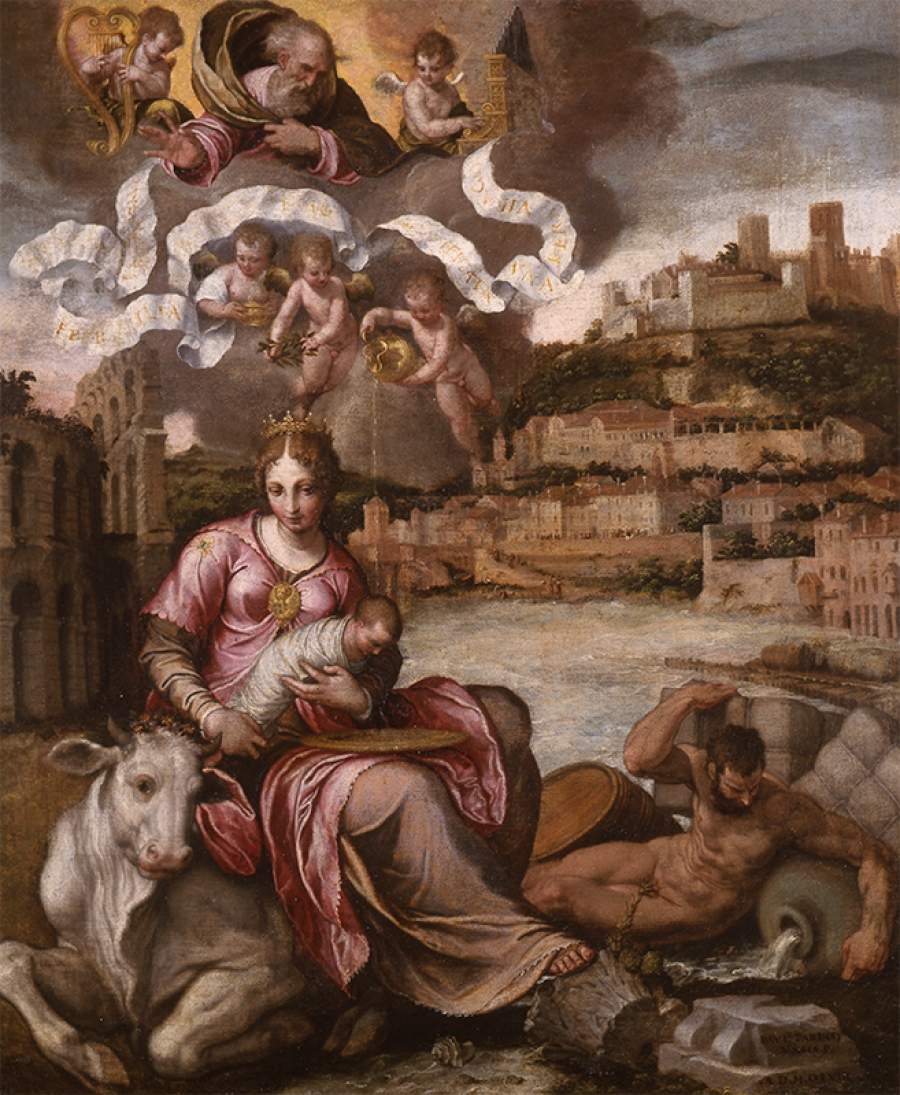Verona, Castelvecchio Museum acquires an important and rare painting by Paolo Farinati
New, important acquisition for the Museo di Castelvecchio in Verona: it is the Allegory of the Baptism of Andriana Verona Ferro, a work by Paolo Farinati (Verona, 1524 - 1606) dated and signed 1558. The work was purchased in January 2021, on a pre-emptive basis from a private individual, by the Ministry of Culture, which accepted the candidacy of the Castelvecchio Museum as a venue for its exhibition, on deposit from the Veneto Regional Museums Directorate, Museum of Palazzo Grimani in Venice.
The work will be exhibited in the Galleria Dipinti di Castelvecchio in a room specially and philologically rearranged to create a dialogue with works by other Veronese artists and Farinati himself, including the canvas close in date with Christ shown to the people and two painted terracottas with St . Paul and St. Anthony Abbot, in Carlo Scarpa ’s historic setting enhanced by a recent energy-efficient and updated lighting system upgrade, which allows the color values of the paintings to be brought out with great vividness from the walls.
This is one of the most important works in Paolo Farinati’s catalog, because of the circumstances in which it was created and because of the extraordinary view of the city of Verona that serves as the setting for the composition. The work was in fact commissioned from Farinati by the City of Verona, in the year 1558, to honor the Venetian captain Girolamo Ferro on the occasion of the birth of his daughter Andriana. It is thus a work celebrating the city institution and the government of the Serenissima.
The painting depicts a sweet-faced young woman sitting as the mythical Europa on the white bull. At the neckline of the pink surcoat on a large gold medallion stands out the lion of St. Mark. The woman, personifying the city of Verona, holds a newborn babe wrapped in swaddling clothes and ready to receive on her downward-facing head the baptismal water that child angels from above are ready to pour. The baptism takes place on the banks of the Adige River, and in perspective we can see some characteristic elements of the city’s landscape: the Arena and the hill, with the two ancient castles of San Pietro and San Felice. The river is personified by a naked young man leaning on an amphora from which the waters flow and holding bales of cloth and barrels, an allusion to the traffic passing along its course. The allegory of Verona is combined with that of the baptism of the newborn, who bears an almost homonymous name from the city (in fact, her name is Andriana Verona Ferro).
“The composition,” explains Francesca Rossi, director of the Civic Museums, in her report to the Ministry, “constitutes a very rare document in the genre of veduta in Veneto in the mid sixteenth century and has the great merit of restoring the physiognomy of the Scaligero urban landscape (with the Arena, the river and the two ancient castles of San Pietro and San Felice on the hill) before the radical transformation undergone by the left bank of the Adige from the Napoleonic age onward, which entailed, among others, the loss of the two historic military fortifications that dominated the hill.”
The author, Paolo Farinati, was born in Verona in 1524 and did most of his work in the city. In his youth in Mantua he came into contact with the painting of Giulio Romano and was strongly influenced by it. His style in his maturity, on the other hand, will be indebted above all to the master Paolo Veronese, his contemporary. Giorgio Vasari reserves words of praise for the painter, appreciating the quality of his drawings and his ability to build in harmony compositions crowded with characters. Farinati’s workshop was very active, receiving commissions for sacred and secular art not only in the city area but elsewhere in Venice’s mainland possessions. His masterpieces, however, are in the palaces and churches of Verona, such as the Multiplication of the Loaves and Fishes at San Giorgio in Braida, theLast Supper at Santa Maria in Organo, and Christ Shown to the People preserved at the Castelvecchio Museum. The discovery of the account book compiled by the painter beginning in 1573 and continuing until his death makes it possible to reconstruct his activity and learn about the lost works. His production includes designs for architecture, engravings, and frescoes expressed in a coherent artistic language rich in sensibility. Paolo Farinati died in 1606 after leaving precise instructions to his sons, especially Orazio, on the continuity of the workshop.
The arrival of the painting at the Castelvecchio Museum constitutes an exceptional renewal and enrichment of the tour. Among other things, it follows by a few months a similar ministerial deposit regarding a Renaissance wooden altarpiece, the “Polyptych of St. Luke,” as a tangible sign of the harmony existing between the Ministry of Culture and Italian civic museums, aimed at supporting the development of the National Museum system. Finally, it is also a testimony to the Ministry’s sensitivity and attention to museums facing great difficulties in the prolonged period of emergency due to the pandemic.
In the photograph, the painting by Paolo Farinati.
 |
| Verona, Castelvecchio Museum acquires an important and rare painting by Paolo Farinati |
Warning: the translation into English of the original Italian article was created using automatic tools. We undertake to review all articles, but we do not guarantee the total absence of inaccuracies in the translation due to the program. You can find the original by clicking on the ITA button. If you find any mistake,please contact us.




























